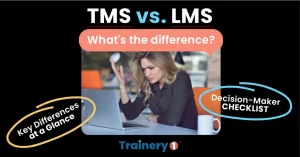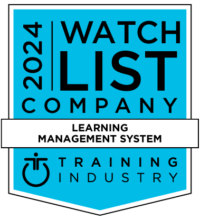Invest The Time To Truly Understand Your LMS Needs
For small companies, investing in a Learning Management System (LMS) is a big decision, whether it’s a first-time purchase or replacing an existing solution. There are many factors and options to consider, and with over 800 vendors on the market, even knowing where to start can feel overwhelming.
With business budgets already tight, it might be tempting to forego any investment and continue to make do with either a labor-intensive training program or stick with an LMS that no longer meets your needs. However, in this year as in last, the agility of your training program is especially critical for business continuity and regulatory compliance. Effective workforce training must remain a top priority.
If you’re struggling to balance your desire for a new LMS with budget constraints, here are 5 considerations for getting the Learning Management System you need at a price you can afford.
1. Prioritize Your Needs For The Next 1-3 Years
It’s easy to fall prey to a lengthy list of features. Instead, look for solutions that target your needs for the next 1-3 years. Start by identifying your pain points. What problems do you need an LMS to solve? Is keeping on top of required training your biggest issue? Or, is it providing timely content?
How will you use the platform? List out your expected use cases and compare that to the features offered. If most of your training is for required safety [1]procedures and/or mandated licensing and certifications, you need an LMS that makes it easy to manage course content and required updates, learning schedules, deadlines, and reporting. Gamification to motivate employee participation isn’t necessary.
Keep in mind that your needs may change, so scalability is important. If your business grows or your training needs evolve, you want something that supports incremental growth without killing next year’s budget.
2. Understand The Scope Of The Solutions
Once you know what you need, narrow it down to an LMS that fits the bill. The platforms available can vary widely in their capabilities, and not all are created equal. Some are designed for handling only basic training administration—managing training delivery and tracking course completion.
Others offer more comprehensive services like content libraries, course building capabilities, and real-time module flexibility to keep content fresh. For a small business, these added features can help to minimize the burden of creating your own content, allowing you to focus on other aspects of running the business.
3. Features To Consider
In addition to the specifics of functionality, look for an LMS platform that offers support to ensure successful implementation and ease-of-adoption by employees. For example:
- Setup/startup
Depending on the vendor, getting started can range from completely self-service to assisted deployment to a full-service implementation. Be honest with yourself about your level of tech-savviness and decide which level of support you need. You’ll of course pay more for high-touch service, but it may be worth it if it means faster startup, faster adoption and use. - Compatibility with HR systems
If you’re already using an HR system, LMS integrations [2] can save you a lot of time and work in keeping up with who needs what training for onboarding, job role change, upskilling, and certifications. A platform that integrates with your HRIS (Human Resource Information System) can also eliminate siloed record-keeping that only adds more work to your plate and introduces the risk of missing critical learning opportunities. - Multi-format capabilities
Not all learners learn the same. Some people absorb material better from a video, others through slides and lectures, and others through interactive programs. For the best learner experience, choose an LMS that accommodates all learning styles to make sure everyone benefits from the material. - Responsive technology for easy mobile access
No matter what your industry or environment, giving employees the opportunity to learn when and where works best for them, on the device they want, will ensure better participation. Platforms that provide a smooth and seamless mobile experience give employees maximum flexibility to increase participation. - Cloud-based versus on-premises
Especially for remote learning capabilities, cloud solutions offer more flexibility and accessibility than proprietary on-premises systems, plus built-in data security and automatic updates with little to no hands-on maintenance required. Cloud platforms also typically offer lower startup costs with modular components you can add on as needs change. - Support
Adequate customer support is critical and LMS platform options range from free/included for comprehensive solutions to pay-per-incident with bare-bones tools. You want a provider that has resources available when employees are doing asynchronous training at 3 a.m. after their shift is over. Many offer self-help resources including a knowledge base, user forums, FAQs, help documentation, and automated chat/troubleshooting, while others offer advanced options like on-demand phone support. - Analytics
Tracking course completion is essential, but you may want to go beyond that to analyze and optimize the learner experience. Are learners having trouble with content? Or taking too long to get through it and giving up? An LMS that tracks real-time learner behavior can help you improve content and delivery to maximize training effectiveness.
4. Know What To Expect To Pay
The cost for most LMS platforms will include the initial implementation/setup and annual licensing. Any upgrades or add-ons, including content licensing or custom content creation, may carry additional fees. Pricing models vary across the board, but the most common are per learner/per month, per learner/per use fee, and a flat-fee per course, which is most common with compliance or specialized programs. Again, start by identifying your needs, do the math, and see which works best for your situation.
Don’t forget to consider the overall value. Aside from out-of-pocket costs, consider the time and hassle an LMS might save you and what that will mean for your business. If it means you’re no longer spending hours each week managing training, you’ll benefit from much greater efficiency, less risk of compliance failure, and an ability to attract and retain talent with a more robust learning program—all of which must be considered in the cost. It’s not just about the line-item expense; it’s about the total ROI, and a great LMS can deliver dividends across every business function.
5. Pitfalls To Avoid
As you consider the options, there are a few things you’ll want to steer clear of. For example, beware of the add-on trap. Like buying a new car, the salesman will always show you the model with all the bells and whistles first to lure you into going for the top-of-the-line model. The price looks good until you find out that all those features are separate add-ons. Make sure you get a full description of what’s included in the contract in writing before you make a decision.
Another vendor “gotcha” to look out for is content ownership. Some LMS vendors will lock you into using only their content, their proprietary authoring tool, or even claiming ownership of the custom content you create and then charging you a fee if you want to switch to another platform. Be sure to ask about this specifically so you don’t end up having to buy your own content back.
Hard to believe, but many businesses make the mistake of not involving IT in the evaluation and decision-making process. As in any new software purchase, IT should always be involved, if for no other reason than for security and compatibility assurances. Your IT team can also help tremendously with installation; otherwise, it may cost you a lot more in the long run.
Finally, don’t forget to plan for the rollout and adoption of the platform. No matter how good the LMS is, it will only bring value if your team uses it. Make sure you have a plan and budget to promote the LMS internally and be sure to focus on the “why” for employees by making the benefits of the new platform employee-centric. Make it clear what’s in it for them.
Even with all the research and careful planning, buying an LMS is a big decision, and it takes time. But investing the time and energy up front in identifying your needs and considering factors beyond the initial purchase price can make it more affordable, and ultimately save you a ton of money down the road.
References:
[1] Interested In Using Our Video Content or Our LMS Courses?
[2] The Advantages Of Integrating Your HRIS With eLearning Platforms







